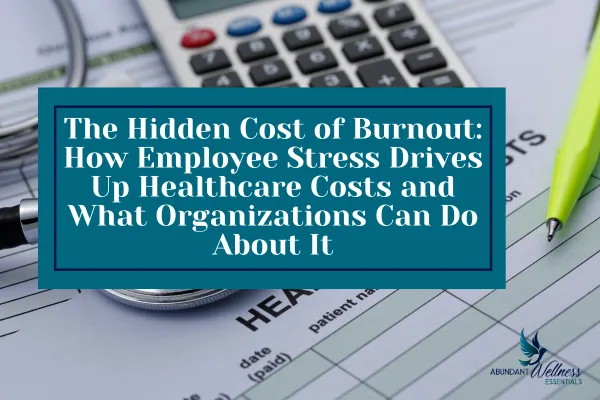
Burnout's Impact on Healthcare Costs: What Leaders Must Know

The Hidden Cost of Burnout: How Employee Stress Drives Up Healthcare Costs and What Organizations Can Do About It
Employee burnout isn't just a workplace wellness issue—it's a financial crisis hiding in plain sight. As a leader in the behavioral healthcare field, I've witnessed firsthand how chronic workplace stress creates a domino effect that dramatically increases healthcare costs while simultaneously destroying organizational culture and productivity.
The Direct Connection: Burnout to Healthcare Costs
How Chronic Stress Affects Physical Health
When employees operate in a constant state of chronic stress, their bodies remain in perpetual fight-or-flight mode. This elevated stress response diverts energy and blood flow away from essential daily functions like digestion and immune system maintenance. The result? Previously healthy employees who never took sick days suddenly become frequent visitors to their doctor's office.
I've observed this pattern repeatedly: high-performing employees who used to have perfect attendance suddenly calling out regularly with head colds, flu, and other recurring illnesses. Upon investigation, the underlying cause is almost always chronic workplace stress.
The Insurance Premium Impact
When multiple employees within an organization develop chronic health conditions simultaneously, the financial impact extends far beyond individual medical bills:
Higher insurance premiums for the entire organization
Increased prescription medication costs
Elevated deductibles and co-pays for all employees
Reduced coverage options as insurance companies adjust risk assessments
The FMLA Crisis: Burnout-Related Leave Requests Surge
Perhaps most alarming is the dramatic increase in Family and Medical Leave Act (FMLA) requests specifically related to burnout. Current statistics suggest that burnout-related leave requests now exceed those for traditional physical health conditions—a concerning trend that signals the severity of this workplace epidemic.
This surge in leave requests creates:
Staffing shortages in already understaffed industries
Increased workloads for remaining employees
Compromised patient/customer care quality
Higher turnover rates as remaining staff become overwhelmed
The Healthcare Industry: A Perfect Storm
The healthcare field exemplifies this crisis perfectly. We're experiencing:
Critical staffing shortages as professionals leave the field entirely
Career changes as healthcare workers become farmers, real estate agents, or pursue other careers
Higher patient acuity requiring more intensive care
Increased caseloads for remaining staff
Decreased care quality due to overworked professionals
The Financial Cost of High Turnover
Organizations often underestimate the true cost of employee turnover. It's significantly more expensive to continuously recruit, interview, hire, and train new staff than to invest in retaining existing employees through burnout prevention programs.
Burnout Prevention: A Strategic Investment, Not an Expense
Why Prevention Saves Money
Investing in burnout prevention isn't just the right thing to do—it's a smart financial strategy. When employees feel supported and healthy, they:
Provide better customer service and patient care
Take fewer sick days and require less medical intervention
Stay with the organization longer, reducing turnover costs
Perform at higher levels when they feel valued
Beyond Wellness Stipends: Creating Systemic Change
While wellness stipends and massage benefits are appreciated, they often provide only temporary relief without addressing root causes. Effective burnout prevention requires:
Cultural Transformation
Positive time-off policies: Support employees' need for genuine breaks
Healthy work-life balance: Recognize that balance looks different for each person
Open communication: Create environments where mental health discussions are normalized
Educational Initiatives
Mental health awareness training
Emotional intelligence workshops
Conflict resolution classes
Leadership development programs
Sustainable Wellness Programs
Skills development opportunities
Career advancement support
Physical health initiatives (beyond sugar-laden office treats)
The ROI of Employee Care
When organizations prioritize employee wellbeing, they see measurable returns:
Improved Retention
Employees who feel seen, heard, and cared for are significantly less likely to leave, reducing costly turnover cycles.
Reduced FMLA Usage
Healthy, supported employees require fewer extended leaves, maintaining staffing levels and productivity.
Lower Healthcare Costs
When employees are genuinely healthy and not just managing chronic stress-related conditions, overall healthcare utilization decreases.
Enhanced Organizational Culture
Sustainable, healthy, collaborative cultures emerge naturally when employee wellbeing is prioritized over pure data and numbers.
The Bottom Line: People-First Approach Drives Profit
Organizations that shift from treating employees as numbers back to valuing them as human beings see remarkable transformations. When you demonstrate genuine care for employee health and wellbeing, those employees will consistently deliver exceptional service to customers and patients.
The choice is clear: invest proactively in burnout prevention, or pay exponentially more in healthcare costs, turnover, and diminished organizational performance.
Take Action: Building Your Burnout Prevention Strategy
As you consider implementing burnout prevention initiatives in your organization, remember that small, consistent efforts to make employees feel valued can yield significant returns. The question isn't whether you can afford to invest in employee wellbeing—it's whether you can afford not to.
What strategies has your organization implemented to create a healthier workplace culture? Share your experiences and let's learn from each other's successes.
